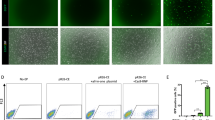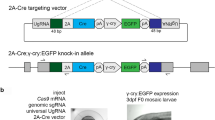Abstract
Development of efficient short-term gene transfer technologies for embryonic stem (ES) cells is urgently needed for various existing and new ES cell-based research strategies. In this study, we present a highly efficient, nonviral non-DNA technology for genetic loading of mouse ES cells based on electroporation of defined mRNA. Here, we show that mouse ES cells can be efficiently loaded with mRNA encoding a green fluorescent reporter protein, resulting in a level of at least 90% of transgene expression without loss of cell viability and phenotype. To show that transgenes, introduced by mRNA electroporation, exert a specific cellular function in transfected cells, we electroporated stably transfected ES cell lines with mRNA encoding FLPe or Cre recombinase proteins in order to excise an FRT- or LoxP-flanked reporter gene. The results, as determined by the disappearance and/or appearance of a fluorescent reporter gene expression, show that FLPe and Cre recombinase proteins, introduced by mRNA electroporation, efficiently exert their function without influence on further culture of undifferentiated ES cell populations and their ability to differentiate towards a specific lineage.
This is a preview of subscription content, access via your institution
Access options
Subscribe to this journal
Receive 12 print issues and online access
$259.00 per year
only $21.58 per issue
Buy this article
- Purchase on Springer Link
- Instant access to full article PDF
Prices may be subject to local taxes which are calculated during checkout



Similar content being viewed by others
References
Lauth M, Spreafico F, Dethleffsen K, Meyer M . Stable and efficient cassette exchange under non-selectable conditions by combined use of two site-specific recombinases. Nucleic Acids Res 2002; 30: e115.
Van Tendeloo VFI et al. Highly efficient gene delivery by mRNA electroporation in human hematopoietic cells: superiority to lipofection and passive pulsing of mRNA and to electroporation of plasmid cDNA for tumor antigen loading of dendritic cells. Blood 2001; 98: 49–56.
Ponsaerts P et al. mRNA-electroporated mature dendritic cells retain transgene expression, phenotypical properties and stimulatory capacity after cryopreservation. Leukemia 2002; 16: 1324–1330.
Magin TM, McWhir J, Melton DW . A new mouse embryonic stem cell line with good germ line contribution and gene targeting frequency. Nucleic Acids Res 1992; 20: 3795–3798.
Nagy A et al. Derivation of completely cell culture-derived mice from early-passage embryonic stem cells. Proc Natl Acad Sci USA 1993; 90: 8424–8428.
Hooper M et al. HPRT-deficient (Lesch–Nyhan) mouse embryos derived from germline colonization by cultured cells. Nature 1987; 326: 292–295.
Solter D, Knowles BB . Monoclonal antibody defining a stage specific mouse embryonic antigen (SSEA-1). Proc Natl Acad Sci USA 1978; 75: 5565–5569.
Werdien D, Peiler G, Ryffel GU . FLP and Cre recombinase function in Xenopus embryos. Nucleic Acids Res 2001; 29: e53–3.
Van den Plas D et al. Efficient removal of Lox-P flanked genes by electroporation of Cre-recombinase mRNA. Biochem Biophys Res Commun 2003; 305: 10–15.
Ringrose L et al. Comparative kinetic analysis of FLP and Cre recombinases: mathematical models for DNA binding and recombination. J Mol Biol 1998; 284: 363–384.
Eisenbarth GS, Walsh FS, Nirenberg M . Monoclonal antibody to a plasma membrane antigen of neurons. Proc Natl Acad Sci USA 1979; 76: 4913–4917.
Adams LD et al. Double lox targeting for neural cell transgenesis. Brain Res Mol Brain Res 2003; 110: 220–233.
Sullenger BA, Gilboa E . Emerging clinical applications of RNA. Nature 2002; 418: 252–258.
Ponsaerts P, Van Tendeloo VFI, Berneman ZN . Cancer immunotherapy using RNA-loaded dendritic cells. Clin Exp Immunol 2003; 134: 378–384.
Acknowledgements
Part of this work was undertaken during a GERON-funded visit by Peter Ponsaerts to the Singh Laboratory. We are indebted to Geron Corporation (Palo Alto, CA, USA) for their support. We thank Dr Karen May from the Singh Laboratory for additional flow cytometric analysis. We also acknowledge support from Grant No. WO.012.02.N (Scientific Research Community FWO) and Grant No. 7.0004.03 (FWO-Levenslijn) of the fund for Scientific Research-Flanders (FWO-Vlaanderen). LVDE holds a PhD fellowship from the Institute for Science and Technology (IWT). VFIVT is a postdoctoral fellow of the FWO-Vlaanderen. We thank Professor Christine van Broeckhoven and Bart De Vil (Transgene Core University of Antwerp) for assistance with ES cell culture. This work was also supported within the frame of the Inter-University Attraction poles (IUAP) program P5/19 of the Belgian Federal Science Policy Office.
Author information
Authors and Affiliations
Rights and permissions
About this article
Cite this article
Ponsaerts, P., Brown, J., Van den Plas, D. et al. Messenger RNA electroporation is highly efficient in mouse embryonic stem cells: successful FLPe- and Cre-mediated recombination. Gene Ther 11, 1606–1610 (2004). https://doi.org/10.1038/sj.gt.3302342
Received:
Accepted:
Published:
Issue Date:
DOI: https://doi.org/10.1038/sj.gt.3302342
Keywords
This article is cited by
-
Reporter gene-expressing bone marrow-derived stromal cells are immune-tolerated following implantation in the central nervous system of syngeneic immunocompetent mice
BMC Biotechnology (2009)
-
Messenger RNA as a Source of Transposase for Sleeping Beauty Transposon–mediated Correction of Hereditary Tyrosinemia Type I
Molecular Therapy (2007)



